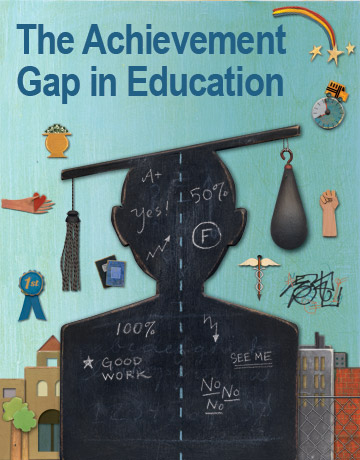Generally speaking, achievement gap refers to outputs—the unequal or inequitable distribution of educational results and benefits—while opportunity gap refers to inputs—the unequal or inequitable distribution of resources and opportunities. Learning gap refers to relative performance of individual students—i.e., the disparity between what students have actually learned and what they were expected to learn at a particular age or grade level.
While particular achievement gaps may differ significantly in degree or severity from group to group or place to place, achievement gaps are defined by their consistency and persistence—i.e., achievement gaps are not typically isolated or passing events, but observable and predictable trends that remain relatively stable and enduring over time.
The most commonly discussed achievement gap in the United States is the persistent discrepancy in national standardized-test scores between white and Asian-American students, two groups that score higher on average, and African-American and Hispanic students, two groups that score lower on average. Another achievement gap that has received considerable attention in recent years is the lagging performance of American students on international tests in comparison to students from other developed countries. Although disparities in test scores tend to be the most discussed, scrutinized, and reported achievement gaps, educational performance and attainment differences may appear in a wide variety of data sets, including graduation rates, college-enrollment rates, college-completion rates, course grades, dropout rates, absenteeism rates, and disciplinary infractions, among many other possible categories of student-achievement data tracked by government agencies, districts, and schools.
Student Groups where Achievement Gap is Evident:
- White and minority students
- Male and female students
- Students from higher-income and lower-income households and communities
- Native English-speaking students and students who are learning English or who cannot speak English, including recently arrived immigrant or refugee students
- Nondisabled students and students with physical or learning disabilities
- Students whose parents have earned a college degree and students whose parents have not earned a college degree (these students are often called first-generationif they decide to enroll in college)
- American students and students from other countries
Causes of Achievement Gap
- Poverty, income inequality, and lower socioeconomic status contributing to reduced accessto educational opportunities, familial support, good nutrition, healthcare, and other factors that tend contribute to stronger educational achievement.
- Minority status giving rise to racism, prejudice, stereotyping, ethnic bias, and institutionalized predispositions—such as the tendency in schools to lower academic expectations for minorities or enroll them in less-challenging courses—that may negatively affect educational achievement.
- Lower-quality schools, ineffective teaching, student overcrowding, dilapidated school facilities, and inferior educational resources, programs, and opportunities in economically disadvantaged schools and communities.
- The disproportionate representation of minority and lower-income students in the lowest-achieving schools, lower-level academic classes, and courses taught by the least experienced or effective teachers.
- Parent and family factors such as low educational attainment, unemployment, or familial instability contributing to reduced academic motivation, disrupted education, or lower educational and career aspirations.
- Little or no English-language understanding, fluency, or literacy contributing to educational underperformance, decreased academic motivation, or higher dropout rates.
- Flawed testing and assessmentdesigns that may inadvertently skew scores for certain groups of students over others, such as computer-based tests administered to students with low technological literacy or tests that are written with a “cultural bias” and use terms, concepts, and situations that may be less understandable to certain groups of students, such as urban minorities or the children of immigrant families.
- The structure of the American system of public schooling and teacher preparation contributing to lower academic performance in comparison to some higher-performing education systemsin other developed countries. In this case, a few internationally administered tests and studies—particularly the Programme for International Student Assessment, the Trends in International Mathematics and Science Study, and the Progress in International Reading Literacy Study—provide the comparative performance data used to determine international achievement gaps.
